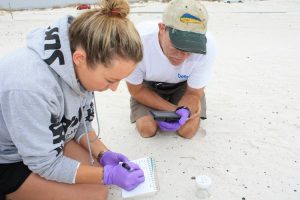Scientists Train Next Generation on Oil Spill Research
– March 25, 2014
As part of ongoing research nearly four years after the Deepwater Horizon oil spill, scientists from the Woods Hole Oceanographic Institution (WHOI, USA) have joined forces with a group of high-school students in Florida to collect remnants of oil from Gulf Coast beaches. Marine chemist Chris Reddy studies how the many compounds that compose petroleum hydrocarbon, or oil, behave and change over time after an oil spill. On 28 February 2014, students worked alongside Reddy and his colleagues from the Florida State University in a living laboratory at a Pensacola shore.
(From SPILL International) — This field expedition is part of a new education initiative called the Gulf Oil Observers (GOO), which trains volunteers to be effective citizen scientists. GOO mentors are educators and scientists associated with the Deep-C Consortium research project – a long-term study investigating the environmental consequences of oil released in the deep Gulf on living marine resources and ecosystem health.
Reddy and his researchers have collected and analysed about 1,000 oil samples from the Gulf Coast since the Deepwater Horizon oil spill.
How the compounds react and weather in the environment also can help inform the chemical industry, governments, and clean-up efforts when future oil spills occur.
The students from West Florida High School of Advanced Technology in Pensacola collected samples of small, round clumps of sand mixed with crude oil. These oiled sand patties can be easily overlooked on the beach. No bigger than a silver dollar, they resemble small dark rocks, driftwood, and other beach debris.
Before going out into the field, the volunteers participated in a series of classroom lessons led by Florida State University educators that covered topics including how to think like a scientist, applying the scientific method, the effectiveness of oil‐eating microbes, and information about the Deepwater Horizon oil spill. They were also trained in sample collection and scientific observation techniques such as how to properly document, photograph, and record observations in the field that they applied to the collection of the reddish-brown oiled sand patties.
The samples collected during the GOO field study will be sent to WHOI for analysis in order to determine what they are comprised of and if they contain oil from the Deepwater Horizon spill. Through the online database, GOO volunteers will be able to track the results of their samples while Deep‐C scientists can use the data to further their research efforts.
While in the field, the students will learn and apply the scientific method and process as part of this ongoing research into the effects of crude oil on the environment funded by a grant from the BP/Gulf of Mexico Research Initiative (GoMRI).
Thus far, Reddy’s research has yielded results. One such finding is that more oil than expected was weathered by a process called oxidation through exposure to sunlight and oil-eating microbes. The scientists have also found that the subtle changes in a compound’s shape or size can affect the rate it biodegrades. This discovery can be applied to the development of new industrial compounds that can quickly break down or last longer when released into the environment.
In April 2010, the Deepwater Horizon drilling rig released an estimated 4.9 million barrels of crude oil into the Gulf of Mexico from a damaged well about 40 miles southeast of the Louisiana coast. Following the disaster, BP made a commitment to grant USD500 million over 10 years to fund an independent research programme designed to study the impact of the oil spill on the environment and public health in the Gulf of Mexico.
The Deep-C (Deep Sea to Coast Connectivity in the Eastern Gulf of Mexico) Consortium is a long-term, interdisciplinary study of deep sea to coast connectivity in the northeastern Gulf of Mexico. The study is investigating the environmental consequences of petroleum hydrocarbon release in the deep Gulf on living marine resources and ecosystem health. Deep-C examines the geomorphologic, hydrologic, and biogeochemical settings that influence the distribution and fate of the oil and dispersants released during the Deepwater Horizon accident, and use the resulting data for model studies that support improved responses to possible future incidents. More than 100 scientists and students at 10 academic and research institutions in the United States and Norway are participating in Deep-C research, which was made possible by a grant from BP/The Gulf of Mexico Research Initiative (GoMRI). The GoMRI is a 10-year independent research program established to study the effect, and the potential associated impact, of hydrocarbon releases on the environment and public health, as well as to develop improved spill mitigation, oil detection, characterisation and remediation technologies.
GoMRI In the news” is a reposting of articles about GoMRI-funded research (published by various news outlets). The author’s interpretations and opinions expressed in these articles is not necessarily that of GoMRI.






